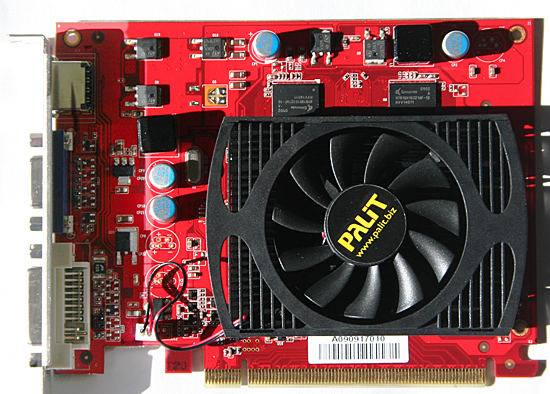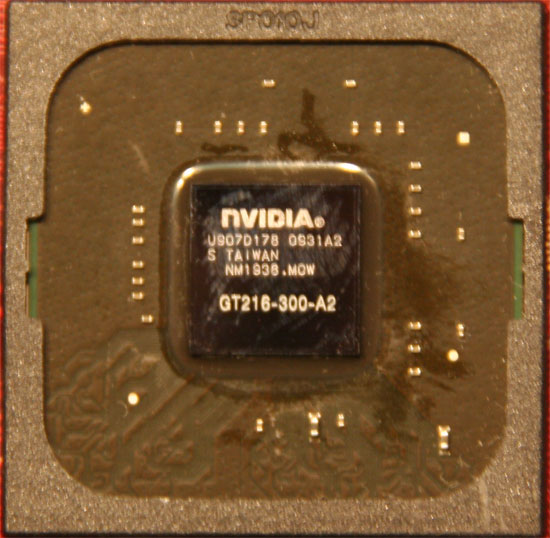NVIDIA’s GeForce GT 220: 40nm and DX10.1 for the Low-End
by Ryan Smith on October 12, 2009 6:00 AM EST- Posted in
- GPUs
There are some things you just don’t talk about among polite company. Politics, money, and apparently OEM-only GPUs. Back in July NVIDIA launched their first 40nm GPUs, and their first GPUs featuring DX10.1 support; these were the GeForce GT 220 and G 210. And if you blinked, you probably missed it. As OEM-only parts, these went into the OEM channel without any fanfare or pageantry.
Today that changes. NVIDIA is moving the GT 220 and G 210 from OEM-only sales to retail, which means NVIDIA’s retail vendors can finally get in on the act and begin selling cards. Today we are looking at one of the first of those cards, the Palit GT 220 Sonic Edition.
| Form Factor | 9600GT | 9600GSO | GT 220 (GDDR3) | 9500GT | G 210 (DDR2) |
| Stream Processors | 64 | 48 | 48 | 32 | 16 |
| Texture Address / Filtering | 32 / 32 | 24 / 24 | 16 / 16 | 16 / 16 | 16 / 16 |
| ROPs | 16 | 16 | 8 | 8 | 8 |
| Core Clock | 650MHz | 600MHz | 625MHz | 550MHz | 675MHz |
| Shader Clock | 1625MHz | 1500MHz | 1360MHz | 1400MHz | 1450MHz |
| Memory Clock | 900MHz | 900MHz | 900MHz | 400MHz |
400MHz |
| Memory Bus Width | 256-bit | 128-bit | 128-bit | 128-bit | 64-bit |
| Frame Buffer | 512MB | 512MB | 512MB | 512MB | 512MB |
| Transistor Count | 505M | 505M | 486M | 314M | 260M |
| Manufacturing Process | TSMC 55nm | TSMC 55nm | TSMC 40nm | TSMC 55nm | TSMC 40nm |
| Price Point | $69-$85 | $40-$60 | $69-$79 | $45-$60 | $40-$50 |
GT 220 and G 210 are based on the GT216 and GT218 cores respectively (anyone confused yet?) which are the first and so far only 40nm members of NVIDIA’s GT200 family. These are specifically designed as low-end cards, with 48 SPs on the GT 220, and 16 SPs on the G 210. The GT 220 is designed to sit between the 9500GT and 9600GT in performance, making its closest competitor the 48SP 9600GSO. Meanwhile the G 210 is the replacement for the 9400GT.
We will see multiple configurations for each card, as NVIDIA handles low-end parts somewhat looser than they do the high-end parts. GT 220 will come with DDR2, DDR3, or GDDR3 memory on a 128bit bus, with 512MB or 1GB of it. So the memory bandwidth of these cards is going to vary wildly; the DDR2 cards will be 400MHz and the GDDR3 cards may go as high as 1012MHz according to NVIDIA’s specs. G 210 meanwhile will be DDR2 and DDR3 only, again going up to 1GB. With a 64bit memory bus, it will have half the memory bandwidth of GT 220.

The GPU configurations will vary too, but not as wildly. NVIDIA’s official specs call for a 625MHz core clock and a 1360MHz shader clock. We’ve seen a number of cards with a higher core clock, and a card with a lower shader clock. Based on the card we have, we’re going to consider 635Mhz/1360Mhz stock for the GPU, and 900MHz stock for GDDR3, and test accordingly.
The transistor count for the GT218 die comes out to 260M, and for GT216 it’s 486M. NVIDIA would not disclose the die size to us, but having disassembled our GT 220, we estimate it to be around 100mm2. One thing we do know for sure is that along with the small die, NVIDIA has managed to knock down power consumption for the GT 220. At load the card will draw 58W, at idle it’s a tiny 7W. We don’t have the power data for the G 210, but it’s undoubtedly lower.

The prices on GT 220 cards are expected to range between $69 and $79, with the cards at the top end being those with the best RAM. This puts GT 220 in competition with AMD’s Radeon HD 4600 series, and NVIDIA’s own 9600GT. The G 210 will have an approximate price of $45, putting it in range of the Radeon HD 4300/4500 series, and NVIDIA’s 9500GT. The GT 220 in particular is in an odd spot: it’s supposed to underperform the equally priced (if not slightly cheaper) 9600GT. Meanwhile the G210 is supposed to underperform the 9500GT, which is also available for $45. So NVIDIA is already starting off on the wrong foot here.
Finally, availability should not be an issue. These cards have been shipping for months to OEMs, so the only thing that has really changed is that now some of them are going into the retail pool. It’s a hard launch and then some. Not that you’ll see NVIDIA celebrating; while the OEM-only launch was no-key, this launch is only low-key at best. NVIDIA didn’t send out any samples, and it wasn’t until a few days ago that we had the full technical data on these new cards.
We would like to thank Palit for providing us with a GT 220 card for today’s launch, supplying us with their GT 220 Sonic Edition.










80 Comments
View All Comments
Ryan Smith - Monday, October 12, 2009 - link
I don't have that information at this moment. However this is very much the wrong card if you're going scientific work for performance reasons.apple3feet - Wednesday, October 14, 2009 - link
Well, as a developer, I just need it to work. Other machines here have TESLAs and GTX280s, but a low end cool running card would be very useful for development machines.I believe that the answer to my question is that it's 1.2 (i.e. everything except double precision), so no good for me.
jma - Monday, October 12, 2009 - link
Ryan, if you run 'deviceQuery' from the Cuda SDK, it will tell you all there is to know.Another goodie would be 'bandwidthTest' for those of us who can't figure out the differences between various DDR and GDDR's and what the quoted clocks are supposed to imply ...
vlado08 - Monday, October 12, 2009 - link
My HD 4670 idles in 165MHz core and 249,8MHz memoy clock and GPU temps 36-45 degrees(passively cooled) as reported by GPU-Z 0.3.5 Is there a possibility that your card didn't lower it's clock during idle?vlado08 - Monday, October 12, 2009 - link
My question is to Ryian of course.Ryan Smith - Monday, October 12, 2009 - link
Yes, it was idling correctly.KaarlisK - Monday, October 12, 2009 - link
The HD4670 cards differ.I've bought three:
http://www.asus.com/product.aspx?P_ID=Z9qnCFnOUNDM...">http://www.asus.com/product.aspx?P_ID=Z9qnCFnOUNDM...
http://www.gigabyte.com.tw/Products/VGA/Products_O...">http://www.gigabyte.com.tw/Products/VGA/Products_O...
http://www.asus.com/product.aspx?P_ID=g6LDXHUo0EzV...">http://www.asus.com/product.aspx?P_ID=g6LDXHUo0EzV...
The first one would idle at 0.9v.
The second would idle at 1.1v. When I edited the BIOS for lover idle voltages, I could not get it to be stable.
The third one turned out to have a much cheaper design - not only did it have slower memory, it had no voltage adjustments and idles at 1.25v (but the correct idle frequency).
vlado08 - Monday, October 12, 2009 - link
Are GT 220 capable of DXVA decoding of h.264 at High Profile Level 5.1?And videos wiht more than 5 reference frames. Because ATI HD4670 can only do High Profile (HiP) Level 4.1 Blu-ray compatible.
Also what is the deinterlacing on GT 220 if you have monitor and TV in extended mode? Is it vector adaptive deinterlacing?
These questions are important for this video card because it is obvious that it is not for gamer but for HTPC.
On HD 4670 when you have one monitor then you have vector adaptive deinterlacing but if you have two monitors or monitor and TV and they are in extended mode then you only have "bob" deinterlacing.
I'm not sure if this is driver bug or hardware limitation.
Ryan Smith - Monday, October 12, 2009 - link
I have another GT 220 card due this week or early next. Drop me an email; if you have something I can use to test it, I will gladly try it out. I have yet to encounter anything above 4.1 though; it seems largely academic.MadMan007 - Monday, October 12, 2009 - link
So my inner nerd that just has to know is confused. Are these truly GT200-based or G9x-based? Different sources say different things. In a way the GT200 series was an improvement on G9x anyway but with enough significant low level changes to make it different. The article calls these GT200 *series* but that could be in name only. It's not clear if that means smaller process cut down die GT200-based or added feature G9x-based.Inquiring nerds want to know!